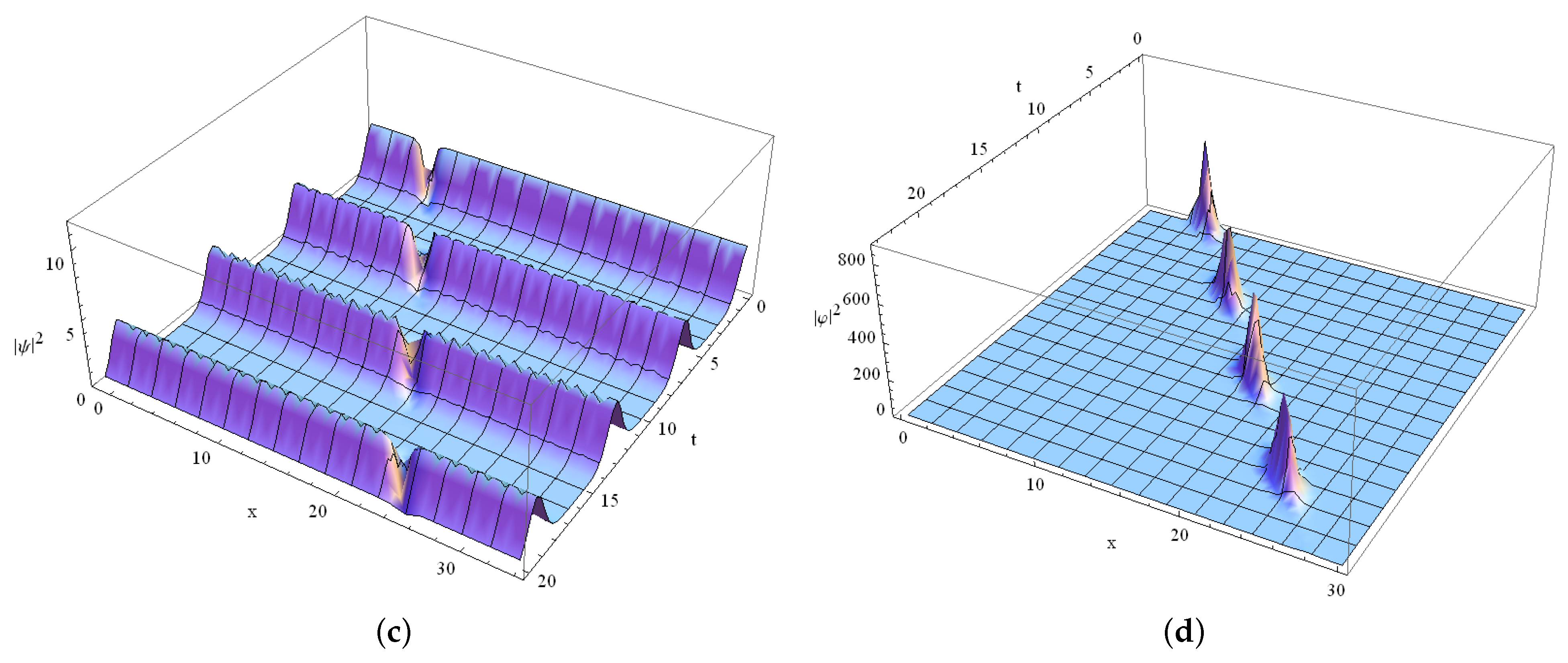On Blow-Up and Explicit Soliton Solutions for Coupled Variable Coefficient Nonlinear Schrödinger Equations
Abstract
:1. Introduction
- It introduces a novel coupled system of Schrödinger equations with variable coefficients. In this regard, our work differs from the models explored in the literature, which typically do not take into account the dynamics of the solutions under the influence of dispersion, potential (linear and quadratic), damping, and nonlinear management all at once.
- It reports on new solitons, rogue waves, and singular solutions to coupled nonlinear Schrödinger systems with variable coefficients. The explicit construction of this important class of solutions demonstrates that coherent structures are possible in the presence of dispersion, potential, damping, and nonlinear management as long as the coefficients fulfill a Riccati system.
- It demonstrates the capacity to control solution dynamics using the Riccati system’s multiparametric solution. To the best of our knowledge, our approach is one of the few capable of analyzing this type of parameter influence. It could be meaningful for manipulating solitons experimentally.
2. Classical Solutions of Coupled NLS
3. Generalized Coupled NLS System
3.1. Rogue Wave Solutions
3.1.1. Case
3.1.2. Case
3.1.3. Case , , , , ,
3.1.4. Case
3.2. Dark–Bright Soliton-Type Solutions
3.2.1. Case
3.2.2. Case
3.3. Bending Dynamics
4. Blow-Up Solutions of the Generalized Coupled NLS System
4.1. Case and Arbitrary h
4.2. Case
5. An n-Dimensional Generalized Coupled NLS System
5.1. Case
5.2. Case
6. Conclusions and Final Remarks
Supplementary Materials
Author Contributions
Funding
Data Availability Statement
Acknowledgments
Conflicts of Interest
Appendix A. Solution of the Riccati System
References
- Shi, Z.; Yang, J. Solitary waves bifurcated from Bloch-band edges in two-dimensional periodic media. Phys. Rev. E 2007, 75, 056602. [Google Scholar] [CrossRef] [PubMed]
- Roskes, G. Some Nonlinear multiphase interactions. Stud. Appl. Math. 1976, 55, 231–238. [Google Scholar] [CrossRef]
- Menyuk, C. Stability of solitons in birefringent optical fibers. Opt. Fibers J. Opt. Soc. Am. B 1998, 5, 392–402. [Google Scholar] [CrossRef]
- Manakov, S.V. On the theory of two-dimensional stationary self-focusing of electromagnetic waves. Zhurnal Eksperimentalnoi Teor. Fiz. 1973, 65, 505–516. [Google Scholar]
- Zakharov, V.E.; Schulman, E.I. To the Integrability of the system of Two coupled Nonlinear Schrödinger Equations. Physica D 1982, 4, 270–274. [Google Scholar] [CrossRef]
- Chen, Z.; Segev, M.; Coskun, T.; Christodoulides, D.; Kivshar, Y. Coupled photorefractive spatial-soliton pairs. J. Opt. Soc. Am. B 1997, 14, 2066–3077. [Google Scholar] [CrossRef]
- Ostrovskaya, E.; Kivshar, Y.; Chen, Z.; Segev, M. Interaction between vector solitons and solitonic gluons. Opt. Lett. 1999, 24, 327–329. [Google Scholar] [CrossRef]
- Busch, T.; Anglin, J.R. Dark-Bright Solitons in Inhomogeneous Bose-Einstein Condensates. Phys. Rev. Lett. 2001, 87, 010401. [Google Scholar] [CrossRef]
- Akhmediev, N.; Ankiewicz, A.; Soto-Crespo, J. Rogue waves and rational solutions of the nonlinear Schrödinger Equation. Phys. Rev. E 2009, 80, 026601. [Google Scholar] [CrossRef]
- Bo-Ling, G.; Li-Ming, L. Rogue wave, Breathers and Bright-Dark-Rogue Solutions for the Coupled Schrödinger Equations. Chin. Phys. Lett. 2011, 28, 110202. [Google Scholar]
- Du, Z.; Tian, B.; Chai, H.P.; Sun, Y.; Zhao, X.H. Rogue waves for the coupled variable-coefficient fourth-order nonlinear Schrödinger equations in an inhomogeneous optical fiber. Chaos Solitons Fractals 2018, 109, 90–98. [Google Scholar] [CrossRef]
- El-Shiekh, R.M.; Gaballah, M. Solitary wave solutions for the variable-coefficient coupled nonlinear Schrödinger equations and Davey–Stewartson system using modified sine-Gordon equation method. J. Ocean. Eng. Sci. 2020, 5, 180–185. [Google Scholar] [CrossRef]
- Han, L.; Huang, Y.; Liu, H. Solitons in coupled nonlinear Schrödinger equations with variable coefficients. Commun. Nonlinear Sci. Numer. Simul. 2014, 19, 3063–3073. [Google Scholar] [CrossRef]
- Kevrekidis, P.G.; Frantzeskakis, D.J. Solitons in coupled nonlinear Schrödinger models: A survey of recent developments. Rev. Phys. 2016, 1, 140–153. [Google Scholar] [CrossRef]
- Liu, X.; Zhou, Q.; Biswas, A.; Alzahrani, A.K.; Liu, W. The similarities and differences of different plane solitons controlled by (3 + 1)-Dimensional coupled variable coefficient system. J. Adv. Res. 2020, 24, 167–173. [Google Scholar] [CrossRef]
- Manganaro, N.; Parker, D.F. Similarity reductions for variable-coefficient coupled nonlinear Schrödinger equations. J. Phys. A Math. Gen. 1993, 26, 4093–4106. [Google Scholar] [CrossRef]
- Ozisik, M.; Secer, A.; Bayram, M. On the examination of optical soliton pulses of Manakov system with auxiliary equation technique. Optik 2022, 268, 169800. [Google Scholar] [CrossRef]
- Pashrashid, A.; Gomez, C.A.; Mirhosseini-Alizamini, S.M.; Motevalian, S.N.; Albalwi, M.D.; Ahmad, H.; Yao, S.W. On travelling wave solutions to Manakov model with variable coefficients. Open Phys. 2023, 21, 20220235. [Google Scholar] [CrossRef]
- Qiu, Y.; Gao, P. New Exact Solutions for the Coupled Nonlinear Schrödinger Equations with Variable Coefficients. J. Appl. Math. Phys. 2020, 8, 1515–1523. [Google Scholar] [CrossRef]
- Yu, F.; Yan, Z. New rogue waves and dark-bright soliton solutions for a coupled nonlinear Schrödinger equation with variable coefficients. Appl. Math. Comput. 2014, 233, 351–358. [Google Scholar] [CrossRef]
- Chakraborty, S.; Nandy, S.; Barthakur, A. Bilinearization of the generalized coupled nonlinear Schrödinger equation with variable coefficients and gain and dark-bright pair soliton solutions. Phys. Rev. E 2015, 91, 023210. [Google Scholar] [CrossRef] [PubMed]
- Zhang, L.L.; Wang, X.M. Bright–dark soliton dynamics and interaction for the variable coefficient three-coupled nonlinear Schrödinger equations. Mod. Phys. Lett. B 2019, 34, 2050064. [Google Scholar] [CrossRef]
- Chai, J.; Tian, B.; Chai, H.P. Darboux transformation and vector solitons for a variable-coefficient coherently coupled nonlinear Schrödinger system in nonlinear optics. Opt. Eng. 2016, 55, 116113. [Google Scholar] [CrossRef]
- Chai, J.; Tian, B.; Zhen, H.L.; Sun, W.R.; Liu, D.Y. Bright and dark solitons and Bäcklund transformations for the coupled cubic-quintic nonlinear Schrödinger equations with variable coefficients in an optical fiber. Phys. Scr. 2015, 90, 045206. [Google Scholar] [CrossRef]
- Chen, W.; Wu, Y.; Jhang, S. On nontrivial solutions of nonlinear Schrödinger equations with sign-changing potential. Adv. Differ. Equ. 2021, 232, 1–10. [Google Scholar] [CrossRef]
- Li, J.; Wang, Y. Nonexistence and existence of positive radial solutions to a class of quasilinear Schrödinger equations in RN. Bound. Value Probl. 2020, 81, 1–14. [Google Scholar]
- Wu, M.; Yang, Z. Existence of boundary blow-up solutions for a class of quasiliner elliptic systems for the subcritical case. Commun. Pure Appl. Anal. 2007, 6, 531–540. [Google Scholar] [CrossRef]
- Pu, J.C.; Chen, Y. Data-driven vector localized waves and parameters discovery for Manakov system using deep learning approach. Chaos Solitons Fractals 2022, 160, 112182. [Google Scholar] [CrossRef]
- Raissi, M.; Perdikaris, P.; Karniadakis, G. Physics-informed neural networks: A deep learning framework for solving forward and inverse problems involving nonlinear partial differential equations. J. Comput. Phys. 2019, 378, 686–707. [Google Scholar] [CrossRef]
- Ho, T.L.; Shenoy, V.B. Binary Mixtures of Bose Condensates of Alkali Atoms. Phys. Rev. Lett. 1996, 77, 3276–3279. [Google Scholar] [CrossRef]
- Timmermans, E. Phase Separation of Bose-Einstein Condensates. Phys. Rev. Lett. 1998, 81, 5718–5721. [Google Scholar] [CrossRef]
- Amador, G.; Colon, K.; Luna, N.; Mercado, G.; Pereira, E.; Suazo, E. On Solutions for Linear and Nonlinear Schrödinger Equations with Variable Coefficients: A Computational Approach. Symmetry 2016, 8, 38. [Google Scholar] [CrossRef]
- Cordero-Soto, R.; Lopez, R.; Suazo, E.; Suslov, S. Propagator of a charged particle with a spin in uniform magnetic and perpendicular electric fields. Lett. Math. Phys. 2008, 84, 159–178. [Google Scholar] [CrossRef]
- Escorcia, J.; Suazo, E. Blow-up results and soliton solutions for a generalized variable coefficient nonlinear Schrödinger equation. Appl. Math. Comput. 2017, 301, 155–176. [Google Scholar] [CrossRef]
- Suazo, E.; Suslov, S.K. Soliton-like Solutions for the Nonlinear Schrödinger Equation with Variable quadratic Hamiltonians. J. Russ. Laser Res. 2012, 33, 63–83. [Google Scholar] [CrossRef]
- Suazo, E.; Suslov, S.K.; Vega-Guzmán, J.M. The Riccati System and a Diffusion-Type Equation. Mathematics 2014, 2, 96–118. [Google Scholar] [CrossRef]
- Pereira, E.; Suazo, E.; Trespalacios, J. Riccati–Ermakov systems and explicit solutions for variable coefficient reaction–diffusion equations. Appl. Math. Comput. 2018, 329, 278–296. [Google Scholar] [CrossRef]
- Kevrekidis, P.; Frantzeskakis, D.; Carretero-Gonzalez, R. Emergent Nonlinear Phenomena in Bose-Einstein Condensates: Theory and Experiment; Springer: Berlin/Heidelberg, Germany, 2008. [Google Scholar]
- Yilmaz, E.U.; Khodad, F.S.; Ozkan, Y.S.; Abazari, R.; Abouelregal, A.E.; Shaayesteh, M.T.; Rezazadeh, H.; Ahmad, H. Manakov model of coupled NLS equation and its optical soliton solutions. J. Ocean. Eng. Sci. 2022, 9, 364–372. [Google Scholar] [CrossRef]
- Cordero-Soto, R.; Suslov, S. The degenerate parametric oscillator and Ince’s equation. J. Phys. A Math Theor. 2011, 44, 015101. [Google Scholar] [CrossRef]
- Lan, Z.Z.; Gao, B.; Du, M.J. Dark solitons behaviors for a (2+1)-dimensional coupled nonlinear Schrödinger system in an optical fiber. Chaos Solitons Fractals 2018, 111, 169–174. [Google Scholar] [CrossRef]
- Manikandan, K.; Senthilvelan, M.; Kraenkel, R.A. On the characterization of vector rogue waves in two-dimensional two coupled nonlinear Schrödinger equations with distributed coefficients. Eur. Phys. J. B 2016, 89, 218. [Google Scholar] [CrossRef]
- Lan, Z.Z. Dark solitonic interactions for the (3 + 1)-dimensional coupled nonlinear Schrödinger equations in nonlinear optical fibers. Opt. Laser Technol. 2019, 113, 462–466. [Google Scholar] [CrossRef]
- Koutschan, C.; Suazo, E.; Suslov, S.K. Fundamental laser modes in paraxial optics: From computer algebra and simulations to experimental observation. Appl. Phys. B 2015, 121, 315–336. [Google Scholar] [CrossRef]
- Suslov, S.K. On integrability of nonautonomous nonlinear Schrödinger equations. Am. Math. Soc. 2012, 140, 3067–3082. [Google Scholar] [CrossRef]
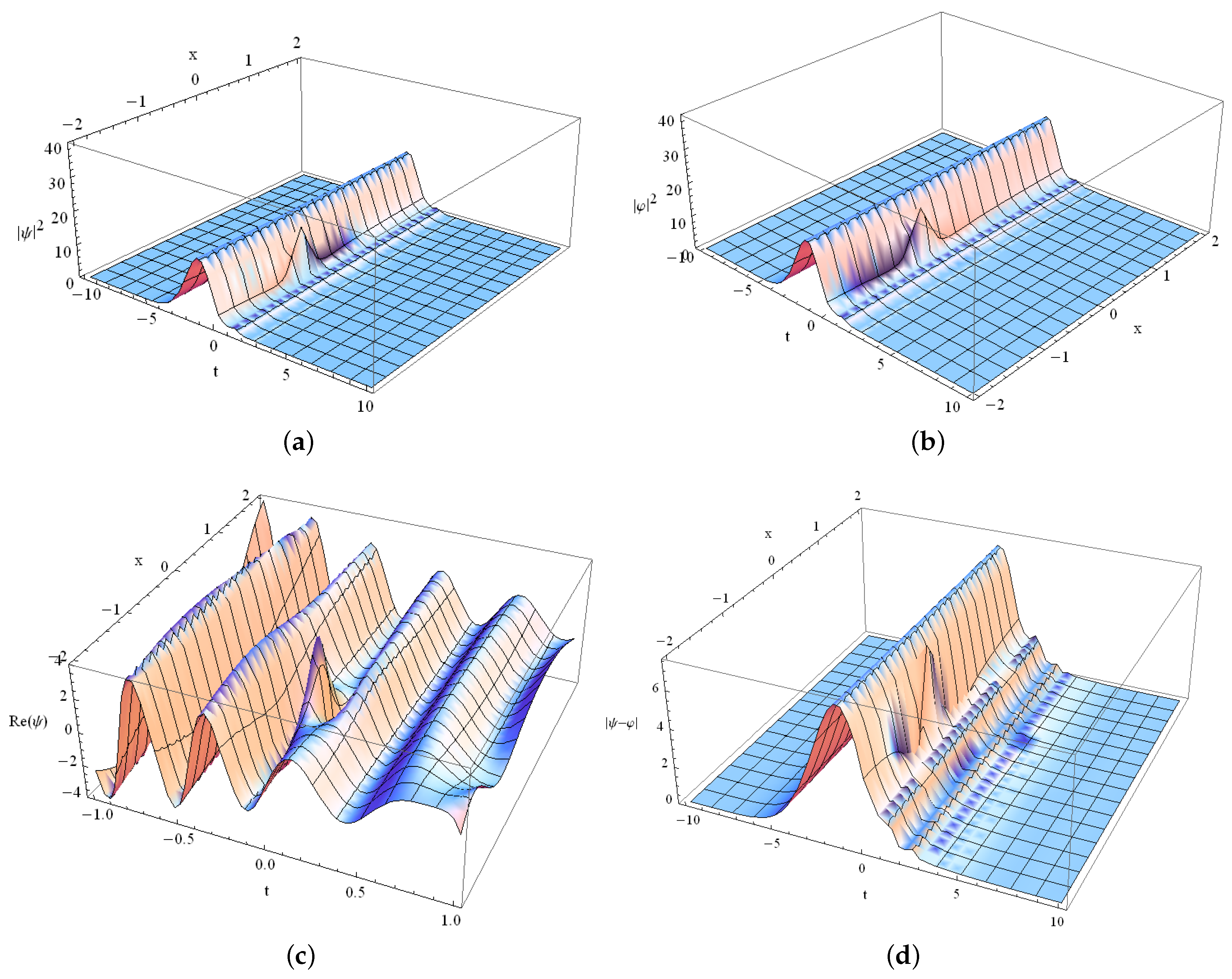
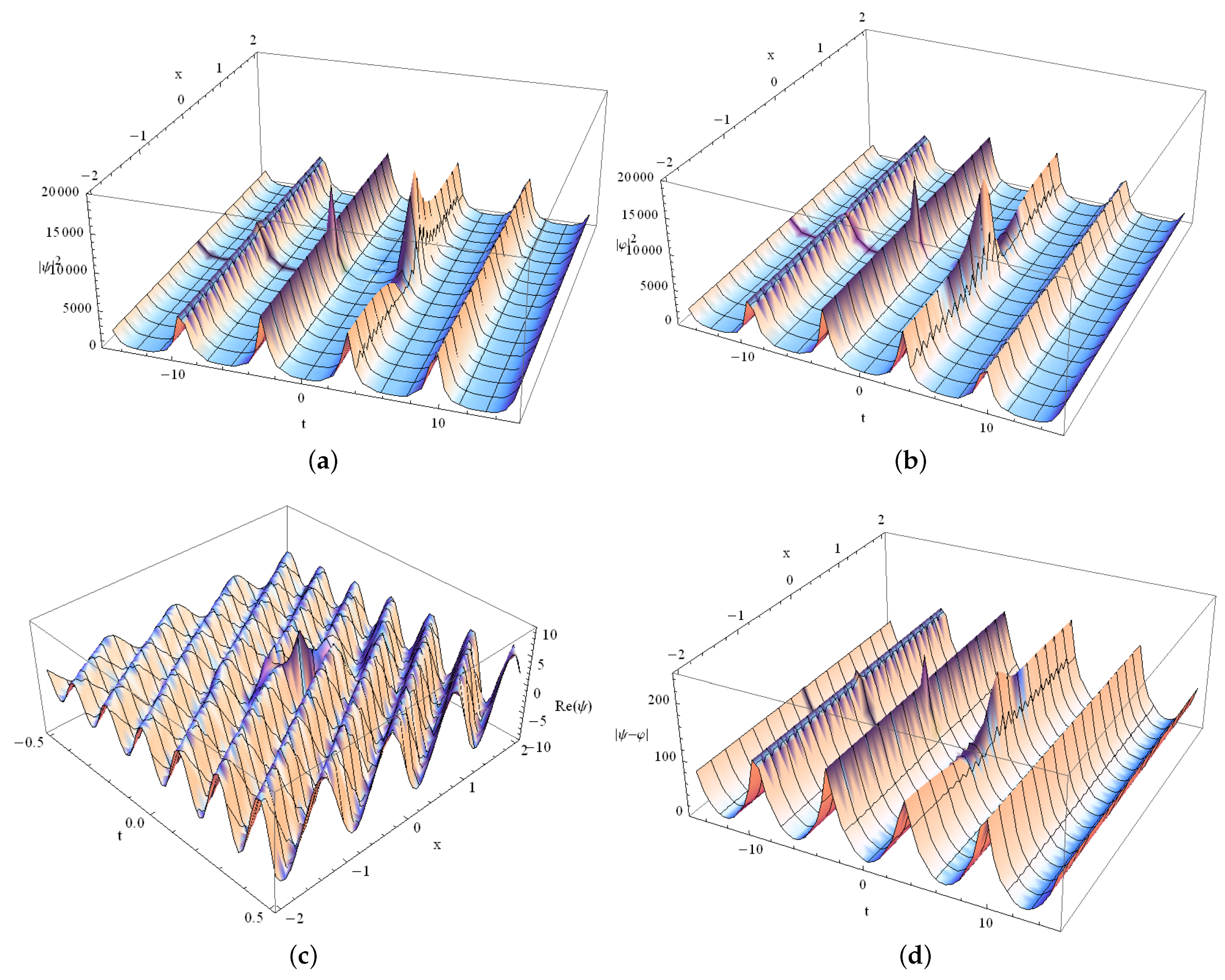
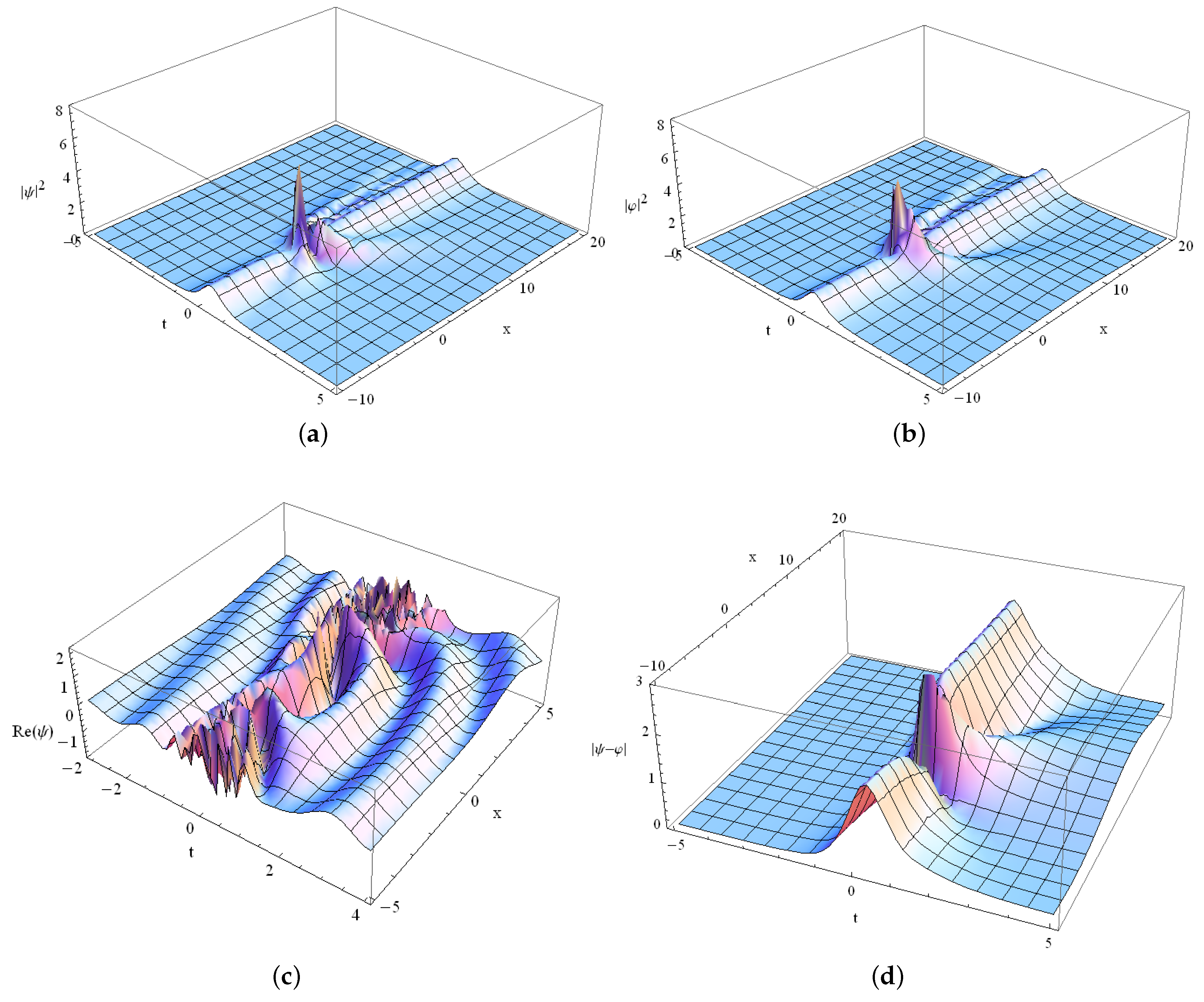

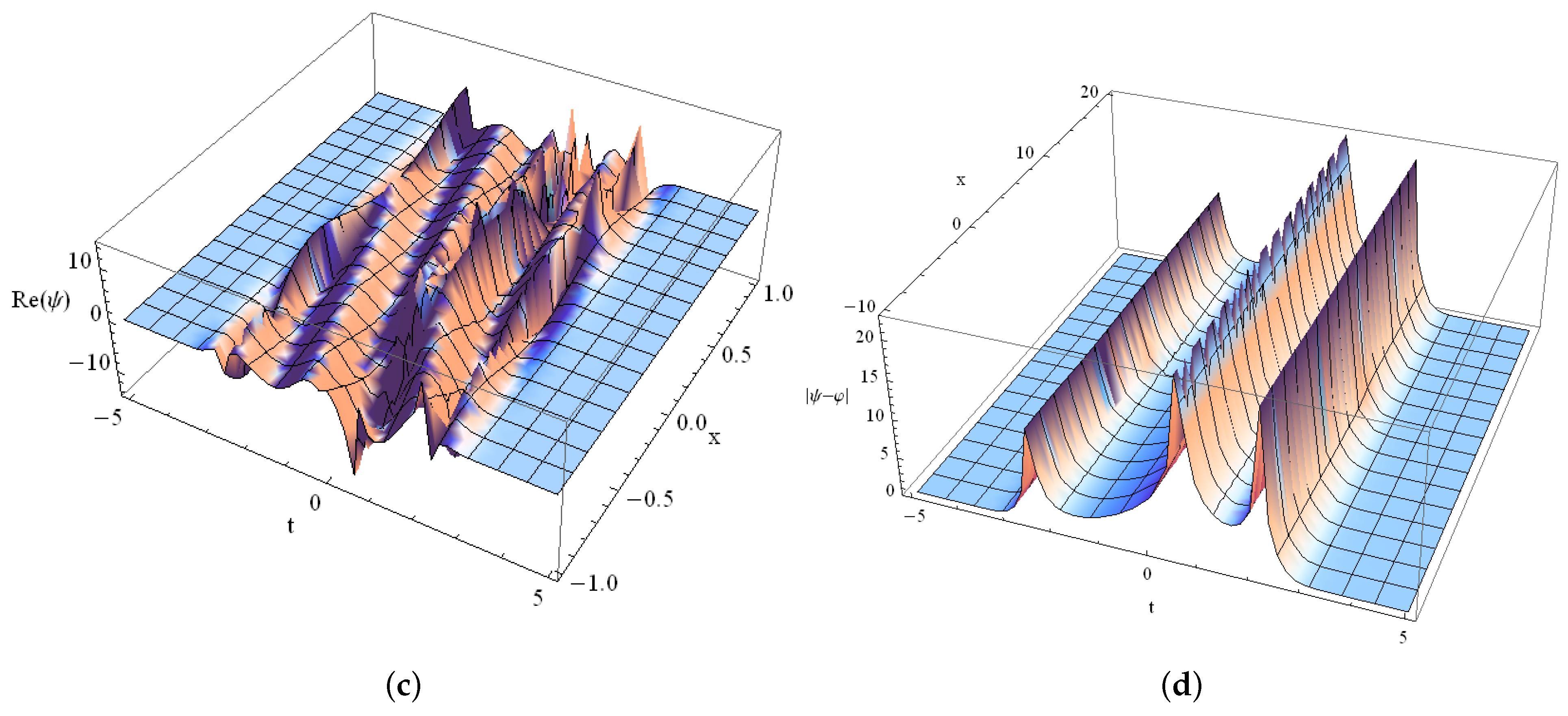
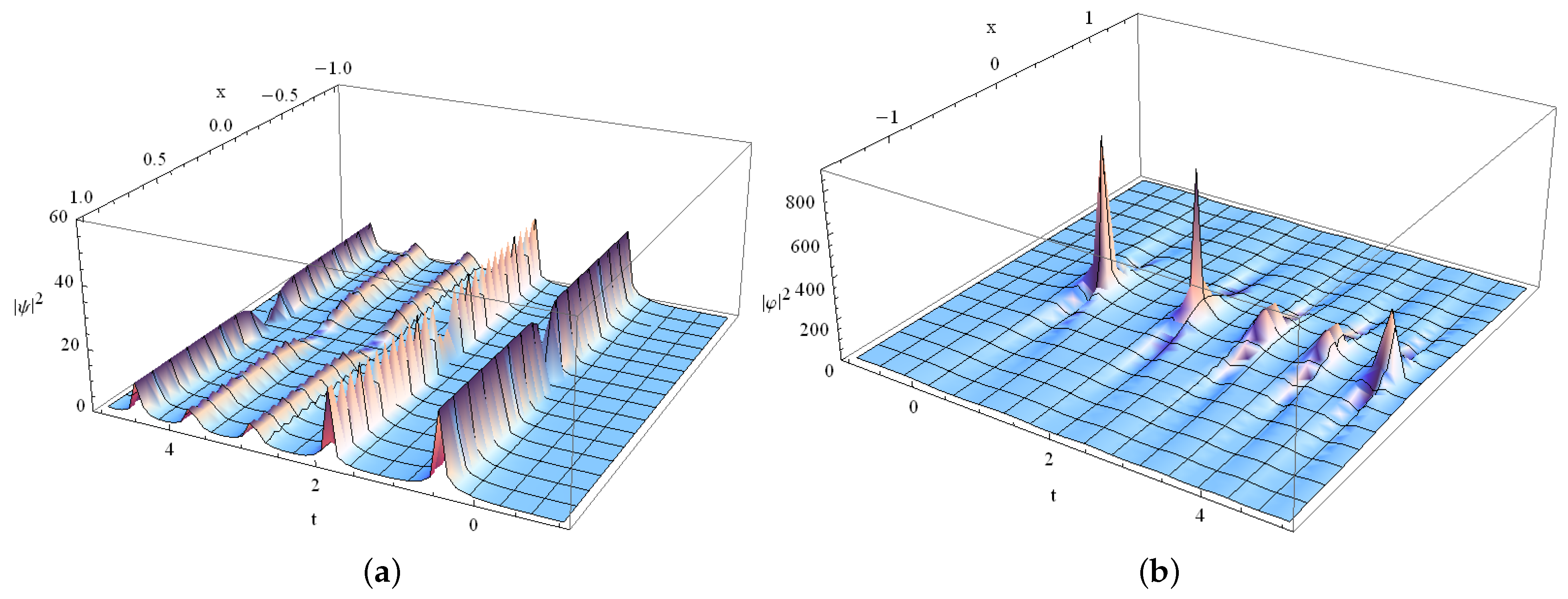
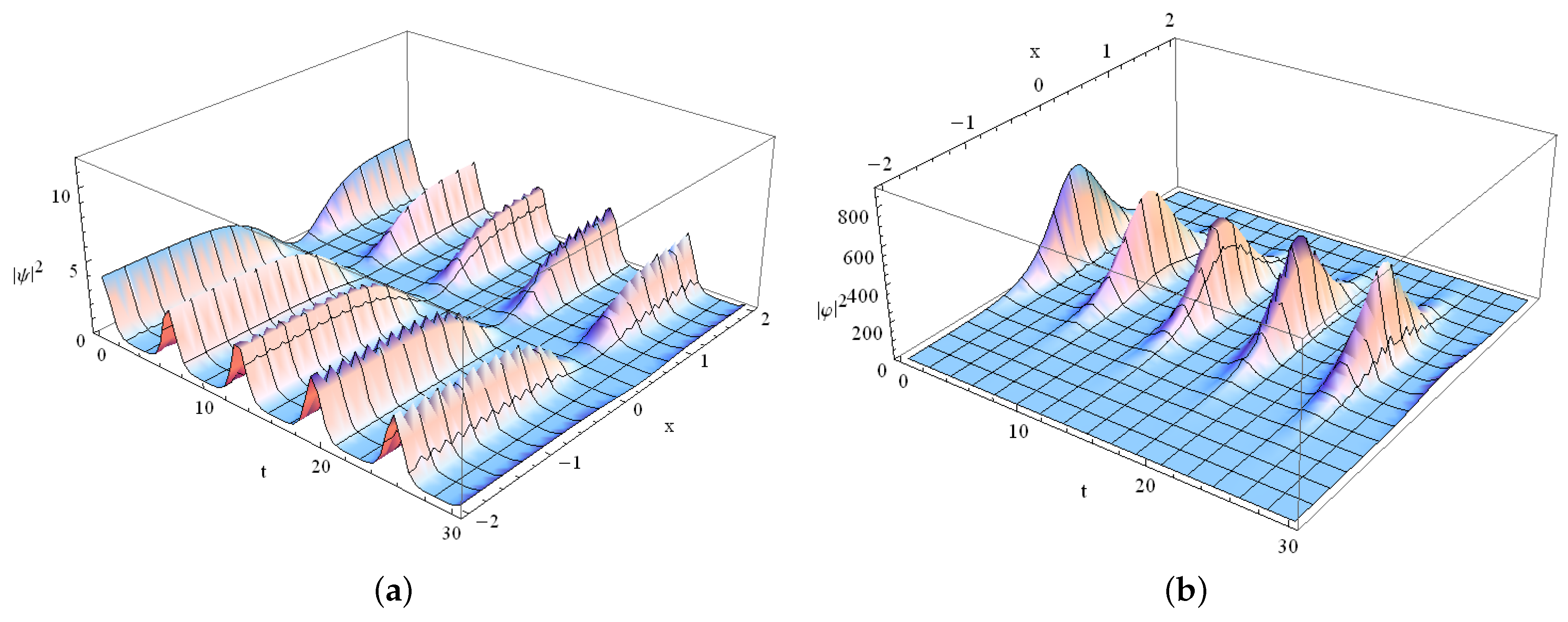
Disclaimer/Publisher’s Note: The statements, opinions and data contained in all publications are solely those of the individual author(s) and contributor(s) and not of MDPI and/or the editor(s). MDPI and/or the editor(s) disclaim responsibility for any injury to people or property resulting from any ideas, methods, instructions or products referred to in the content. |
© 2024 by the authors. Licensee MDPI, Basel, Switzerland. This article is an open access article distributed under the terms and conditions of the Creative Commons Attribution (CC BY) license (https://creativecommons.org/licenses/by/4.0/).
Share and Cite
Escorcia, J.M.; Suazo, E. On Blow-Up and Explicit Soliton Solutions for Coupled Variable Coefficient Nonlinear Schrödinger Equations. Mathematics 2024, 12, 2694. https://doi.org/10.3390/math12172694
Escorcia JM, Suazo E. On Blow-Up and Explicit Soliton Solutions for Coupled Variable Coefficient Nonlinear Schrödinger Equations. Mathematics. 2024; 12(17):2694. https://doi.org/10.3390/math12172694
Chicago/Turabian StyleEscorcia, José M., and Erwin Suazo. 2024. "On Blow-Up and Explicit Soliton Solutions for Coupled Variable Coefficient Nonlinear Schrödinger Equations" Mathematics 12, no. 17: 2694. https://doi.org/10.3390/math12172694





